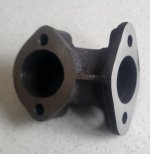In a moment of self doubt, I've checked the camshaft alignment today. With the rocker cover off, you can rotate the push rods freely with your fingers until the cam pushes them against the rocker arm. The inlet pushrod stops rotating 60° BTDC and loosens off 79° ABDC. Assuming 14.5° of ramp, it suggested the cam was set to 45/65 rather than 35/70. With 38 teeth on the cog, I guessed that it was 1 tooth out.
So I took the cover off and rotated the crank until the dot was in the right place. There was a heart-stopping moment when the other dot didn't come in to view. A deep breath later and I worked out that the dots would only align once every other rev. One turn of the crank later and the dots were in the right place. While I was at it, I bent back the retaining plates and checked the bolt torques. I worry too much.
View attachment 440806



